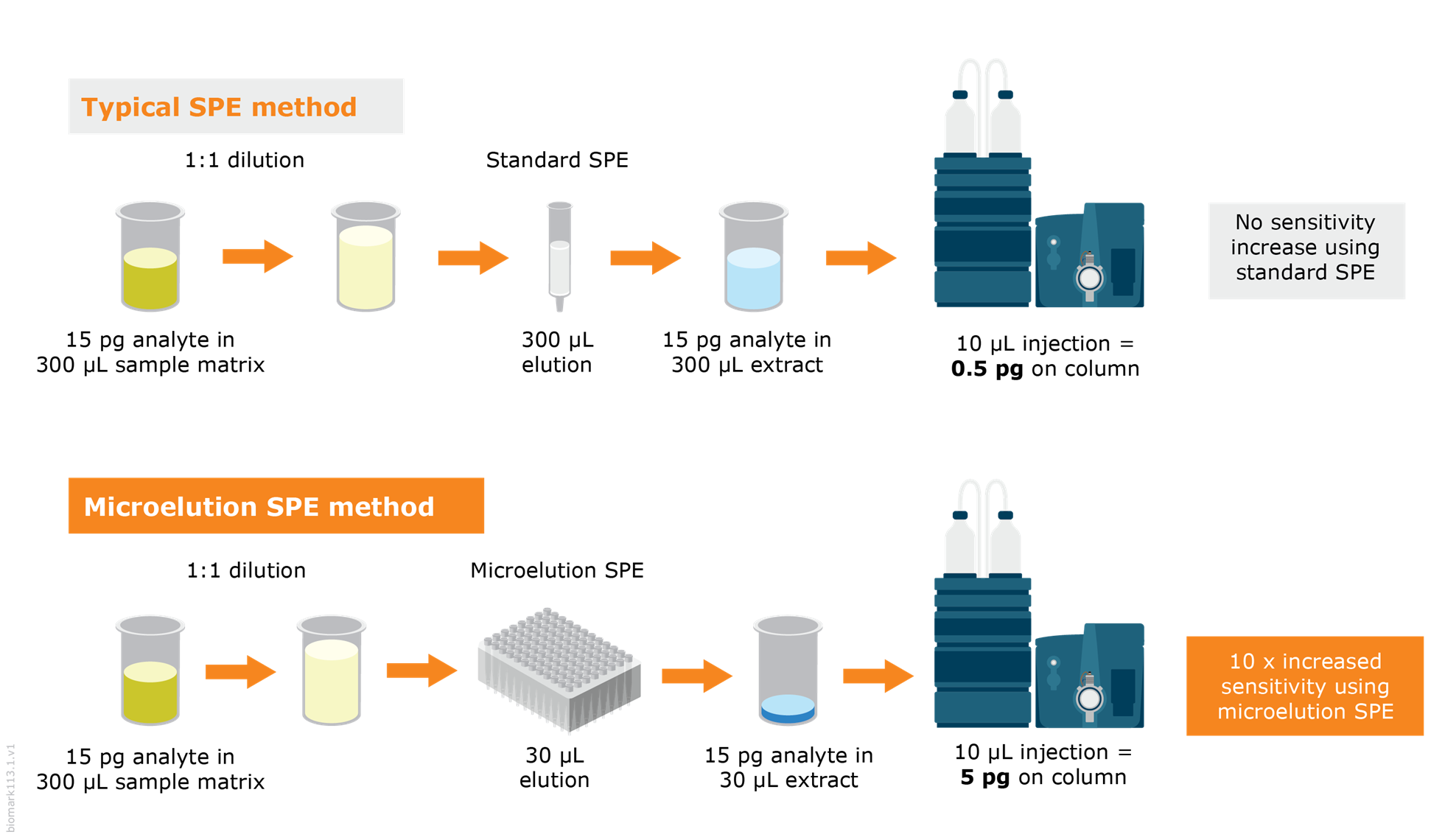Solid phase extraction (SPE) is frequently used for sample clean up, trace enrichment (pre-concentration of the sample), or a combination of both prior to analysis. But can solid phase extraction be an effective tool when bioanalysis demands higher sensitivity and reproducibility with decreasing sample volumes? In theory, SPE can be used for targeted extractions with ultra-high concentrations. As we will see, putting this into practice requires miniaturization of SPE extraction using sorbent beds with optimal formats that minimize elution volume to maximize detection and quantitation power.
Lower elution volume increases analytical power
The power of SPE extraction to clean up samples depends largely on the type of media and combination of solvents used to selectively remove matrix components. Extremely targeted extraction is possible using mixed-mode media with optimized methodology that delivers protein- and phospholipid-free extracts with low matrix effects for analysis.
However, when we’re talking about sample volumes of 300 µL or below, can a high concentration effect be achieved without including an evaporation step? As well as being time consuming, evaporation and reconstitution can throw up some practical challenges with volatile or thermally labile analytes. For particularly hydrophobic analytes, you can lose analyte due to binding to the walls of the evaporation plate or through difficulties in resolubilizing in low solvent volumes.
Microelution SPE is an excellent alternative to conventional SPE + evaporation. Microelution SPE devices are essentially miniature versions of the conventional 96-well SPE plate or column. Instead of 10–30 mg or more of sorbent, microelution SPE devices contain as little as 2 mg sorbent, enabling minimal elution volumes to deliver concentrated samples for high-sensitivity analysis.
Smooth transitions to optimal solvents
Sometimes, it’s not possible to elute in a solvent that is suitable for direct injection into, for example, an LC-MS/MS system. You could evaporate and reconstitute in a more appropriate solvent, although this might be difficult for analytes that aren’t particularly soluble. Alternatively, microelution SPE enables you to elute in a low volume and dilute to match the needs of the analytical method without losing sensitivity. The result is high analyte recovery and great sensitivity while reducing solvent usage and cost and improving laboratory throughput.
Tall and narrow — the best SPE column format
Microelution isn’t just about miniaturizing the sorbent bed — you should ensure that your chosen microelution product has the best format to deliver pure samples in a concentrated form with high recovery.
Solid phase extraction is very much a digital technique. And in an ideal situation it is all about catch (retention of the analytes) and release (elution). So, capacity is about the ability to catch all the analyte(s) of interest in a sample. Ideally, the analytes hit the sorbent bed and stop moving. But, if the retention mechanism isn’t quite strong enough they can move through the bed on loading. There might also be some movement during wash steps if the wash solvent is a little stronger than the loading solvent.
In a traditional SPE plate or column, the capacity of very small sorbent beds (approximately 10 mg) is relatively low because the sorbent layer is wide and shallow. And because of the bed dimensions, you need higher eluting solvent volumes that result in little or no concentration, which means having to include an evaporation step to achieve the required concentration factor.
The risk of analytes breaking through is less likely with a deeper and narrower bed, which means that deeper sorbent beds have a higher effective capacity. Not only that, when you apply a very small volume of elution solvent, it can cover the entire surface area, and flow evenly through the bed to release all the analyte of interest.

This is why efficient microelution SPE products have a sorbent bed that is relatively tall and narrow, enabling sorbent beds of as little as 2 mg of sorbent to have much higher effective capacities than a conventional SPE products containing the same amount of sorbent would have, resulting in higher analyte recovery. The optimized taller, narrower bed dimensions enable elution in volumes as low as 30 µL to give you high analyte recoveries. That means a high concentration factor is easy to achieve, and the time-consuming evaporation step can be eliminated along with its associated problems.
SPE extraction to meet demanding analytical needs
Microelution SPE is a highly efficient route to improving sensitivity without impacting extract purity, throughput or lab efficiency. To achieve this performance, Biotage has developed Mikro SPE products with optimized formats that deliver purified samples in a concentrated form without the drawbacks of an additional evaporation step. The result is efficient and robust sample prep that matches the detection limits of highly sensitive analytical instruments.
Find out how Biotage Mikro SPE products can improve sensitivity.

